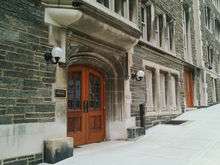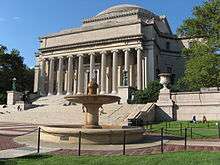Columbia University Department of Middle Eastern, South Asian, and African Studies
| Location | New York City, New York |
|---|---|
| Website |
www |
The Columbia University Department of Middle Eastern, South Asian, and African Studies (MESAAS) is a leading center for the study of history, politics, culture, and languages of the Middle East, South Asia, and Africa. With more than forty faculty members, core and adjunct, MESAAS houses a large number of world-renowned scholars, some of whom have had important contributions as public intellectuals in addition to their scholarly productions.[1]
History

Columbia University, founded as King’s College in 1754 under a charter from the British crown, appointed its first Professor of Oriental Languages in 1784. In the later nineteenth-century the study of Hebrew, Sanskrit, and other Oriental languages became part of the graduate program. By 1890, Oriental Languages became one of the six departments in the Faculty of Philosophy. In 1891 a chair of Indo-Iranian Languages was established. A. V. Williams Jackson, a Columbia Ph.D., was appointed to the chair in 1895. "The scholars of Indo-Iranian philology subsequently broke away to join the anthropologist Franz Boas in the new Department of General and Comparative Linguistics. Oriental Languages, under the leadership of Richard Gottheil, narrowed its name to the Department of Semitic Languages. Gottheil trained several scholars who went on to organize and lead other departments, including William Popper (later chair of the Department of Near East Languages at Berkeley) and Philip Hitti (founder of the Near Eastern Studies program at Princeton)."[2] In the mid 1960s the department expanded to include scholars from the departments of history and international affairs. "Reflecting the expansion into modern history and politics, the name was revised once more, in 1965, from Near and Middle East Languages, to Middle East Languages and Cultures, or MELAC."[3] In 1992 the name of the department was changed to Middle East and Asian Languages and Cultures. "Using the term Asian rather than South Asian made the name scarcely more accurate, but ensured that the department’s new acronym, MEALAC, sounded the same as its previous one."[4]
"In 2005, the Department began the most rapid expansion in its history, recruiting a number of faculty in South Asian and Middle Eastern Studies, and in 2007 it extended its geographical and intellectual scope to include African studies. After doubling in size over the previous decade, the department had outgrown its home in Kent Hall and in 2009 moved to new offices in Knox Hall. To coincide with the move and the expanded focus, the faculty decided to change the department’s name to MESAAS, the Department of Middle Eastern, South Asian, and African Studies."[5]
Graduate program
The graduate program offers both Ph.D. and M.A. degrees. The free-standing Master's Program is designed for students who need more preparation before applying to a Ph.D. program, who want to take courses in a range of subjects before deciding on a discipline for the Ph.D., or who want graduate-level training as preparation for a career beyond the university. Each year, the department selects a small number of highly qualified candidates for the Ph.D. program. The Ph.D. degree can apply to the doctoral program with or without a Master's degree; those without an M.A. will receive one in their course of study. Students admitted to the Ph.D. program are normally awarded five years of financial support, including full-tuition fellowships and stipends. The fellowship carries Teaching Assistant duties in preparation for the academic market.[6]
Ph.D. students are required to take a full year of theories and methods and train in three languages in addition to English. High proficiency in a first MESAAS language (usually the one used to fulfill the M.A. language requirement), proficiency in a second MESAAS language, and reading competence in a third language (a research language, meaning a modern language other than English in which there is a substantial body of scholarship in the student's field of study) are required. High proficiency is normally achieved by completing a fourth-year language course or the equivalent, and proficiency by completing coursework at the intermediate (second-year) level. Reading competence is demonstrated by taking a proficiency exam, or the rapid readings and translation course (or equivalent) offered by other Columbia language departments. The duration of Ph.D. training takes between five to seven years.
The directory of graduate students lists current students and recent graduates of the M.A. and Ph.D. programs.
MESAAS languages
A list of MESAAS Languages:
Other languages are also taught during certain semesters, including Armenian, Sanskrit, Tamil and Ottoman Turkish.
Notable faculty
- Partha Chatterjee is a professor in MESAAS and Anthropology, specializing in political theory, history, postcolonial studies, and nationalism.
- Hamid Dabashi is the Hagop Kevorkian Professor of Iranian Studies and Comparative Literature specializing in history of Iran, Islamic Studies, Shi'ism, aesthetics and cultural and literary theory.
- Souleymane Bachir Diagne is a Professor of African Literature and Philosophy, affiliated with the Institute of African Studies (IAS) and head of the School of International and Public Affairs' African Studies Program. His work is focused on the history of logic and mathematics, epistemology, the tradition of philosophy in the Islamic world, identity formation, and African literatures and philosophies.
- Mamadou Diouf is a professor of Western African history and director of the Institute of African Studies at School of International and Public Affairs, Columbia University.
- Wael Hallaq is the Avalon Foundation Professor in the Humanities. He specializes in Islamic law and Islamic intellectual history.
- Sudipta Kaviraj specializes in intellectual history and South Asian politics.
- Rashid Khalidi is the Edward Said Professor of Arab Studies at Columbia University. He also serves as the director of the Middle East Institute of Columbia's School of International and Public Affairs.
- Mahmood Mamdani is the Herbert Lehman Professor of Government in MESAAS, International Affairs, and Anthropology. He specializes in the study of African history and politics.
- Joseph Massad is a professor of Modern Arab Politics and Intellectual History. He specializes in theories of identity and culture.
- Timothy Mitchell is the chair of MESAAS and a political theorist and historian. He specializes in colonialism and its place in the formation of modernity.
- Sheldon Pollock is the William B. Ransford Professor of Sanskrit and Indian Studies.
- George Saliba is a professor of Arabic and Islamic Science. He specializes in the development of scientific ideas from Late Antiquity till early modern times within the Islamic civilization context.
References
- ↑ "MESAAS | Faculty News". www.columbia.edu. Retrieved 2016-06-16.
- ↑ MESAAS | Information | A History of MESAAS
- ↑ MESAAS | Information | A History of MESAAS
- ↑ MESAAS | Information | A History of MESAAS
- ↑ MESAAS | Information | A History of MESAAS
- ↑ "MESAAS | Graduate Program". www.columbia.edu. Retrieved 2016-06-16.
